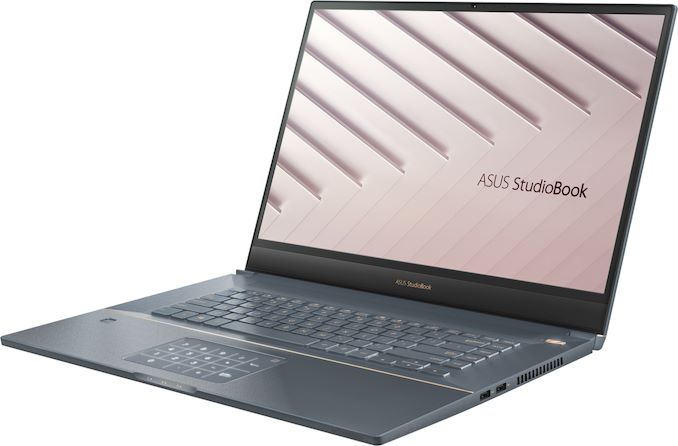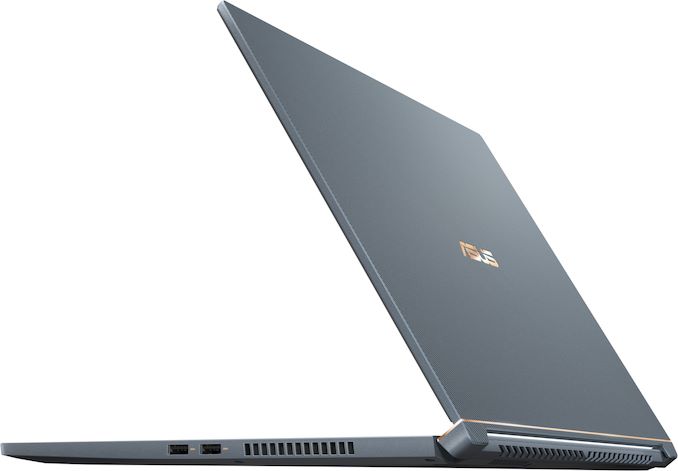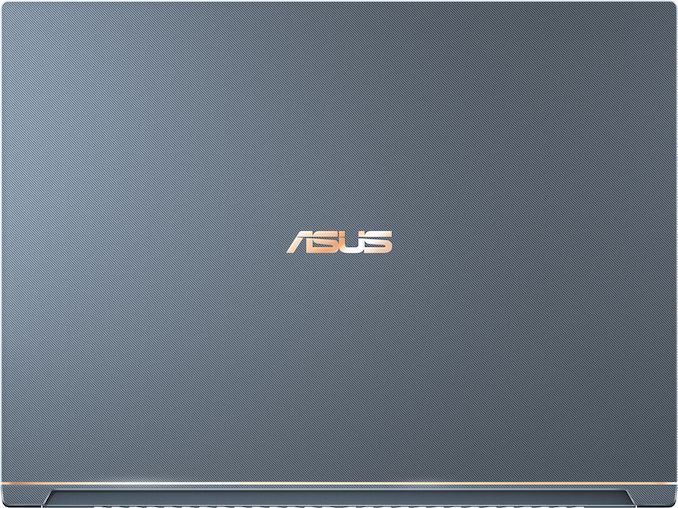CES 2019: ASUS Reveals StudioBook S W700 Workstation with Xeon & Quadro
by Anton Shilov on January 17, 2019 3:00 PM EST
At CES this year, ASUS introduced its first mobile workstation aimed at professionals who work with graphics applications. The new system can be equipped with six-core Intel Core or Xeon processors, NVIDIA’s Quadro GPUs, and a factory-calibrated 17-inch display panel validated by Pantone.
These days a leading supplier of premium laptops for consumers, gamers, and prosumers, ASUS inevitably needed a new market to enter in a bid to keep its PC market share growing. Mobile workstations are a relatively niche market controlled primarily by Dell, HP, and Lenovo, but it is very stable in terms of volumes and also offers rather lucrative margins. Since ASUS clearly knows how to build competitive PCs, it's not surprising to see the company try its luck with mobile workstations.
The ASUS StudioBook S W700-series comes in a Turquoise Grey aluminum chassis and is based on Intel’s six-core Core i7-8750H or Xeon E-2176M processors, and are accompanied by NVIDIA’s Quadro P3200 GPU with 6 GB of GDDR5 memory. To cool down the powerful CPU and GPU, ASUS uses a cooling system featuring five heat pipes, and I suspect is similar to the coolers used for the company’s gaming notebooks.
Depending on exact model, the system may be equipped with up to 64 GB of DDR4-2667 memory (with or without ECC support in case of Xeon) and up to two M.2 PCIe/NVMe SSDs (2TB each), which can be further put RAID 0/1 mode.
One of the key components of any graphics workstation is of course its display. ASUS outfits its StudioBook S W700-series with its 17-inch NanoEdge anti-glare 8-bit display panel, which sports a 1920×1200 resolution and 178° viewing angles. The display has also been validated by Pantone; it can reproduce 97% of the DCI-P3 color space, and it is factory calibrated to Delta E < 2 color accuracy.
Moving on to connectivity, the StudioBook S has an 802.11ax + Bluetooth 5.0 controller, a Thunderbolt 3 port (enabled by Intel’s latest ‘Titan Ridge’ JHL7340 controller), three USB 3.1 Gen 2 Type-A ports, one HDMI 2.0 port, an SD 4.0/UHS-II card reader, and a 3.5-mm headphone jack. The laptop is also equipped with an HD webcam, a microphone array, a fingerprint reader, a keyboard with a 1.4 mm travel distance, and a touchpad with numbers that can be used like a numpad for the calculator app.
Courtesy of its relatively thin 5.3-mm LCD bezels, the 17-inch screen fits in a chassis that is comparable to those used for 15-inch mobile workstations (which tend to be pretty bulky anyhow). The z-height of the ASUS StudioBook S is 1.84 cm, whereas its weight is around 2.39 kilograms
| The ASUS StudioBook S General Specifications | |||||
| W700G3P | |||||
| Display | Diagonal | 17" | |||
| Resolution | 1920×1200 | ||||
| Color Gamut | DCI P3: 97% | ||||
| CPU | Intel Xeon E-2176M processor: 6C/12T, 2.7 - 4.4 GHz, 12 MB Intel Core i7-8750H processor: 6C/12T, 2.2 - 4.1 GHz, 9 MB |
||||
| RAM | Up to 64 GB DDR4-2667 with or without ECC | ||||
| Graphics | NVIDIA Quadro P3200 with 6 GB of memory | ||||
| Storage | Up to two PCIe 3.0 x4 SSDs | ||||
| Wi-Fi | 2×2 802.11ax Wi-Fi module | ||||
| Bluetooth | BT 5.0 | ||||
| General Ports | 1 × Thunderbolt 3 for data, display output (DP 1.4) 3 × USB 3.1 Gen 2 1 × HDMI 2.0 1 × SD/UHS-II card reader |
||||
| Other I/O | HD webcam, TRRS connector for audio, speakers, microphone array | ||||
| Dimensions (H × W × D) | 38.2 × 28.6 × 1.84 cm 15.03 × 11.25 × 0.72 inches |
||||
| Weight | 2.39 kg | 5.27 pounds | ||||
| Battery Life | 57 Wh | ||||
| Price | ? | ||||
ASUS will start sales of its StudioBook S W700-series mobile workstations in the coming months. Prices and exact configurations will be disclosed at launch.
Related Reading:
- ASUS at CES 2019: ProArt PA32UCX 4K Monitor with 1000-Zone FALD Unveiled
- ASUS Launches Mini PC ProArt PA90: A Tiny Workstation w/ Core i9 & Quadro
- ASUS Details ZenBook Pro UX480 with ScreenPad, Whiskey Lake, & dGPU
- ASUS Demonstrates ProArt PA34V Professional Curved UWQHD Display with TB3
Source: ASUS














19 Comments
View All Comments
PeachNCream - Friday, January 18, 2019 - link
Yes, reduction in material requirements are a good thing for a number of reasons. I get that and agree that from a few different perspectives, it is a good idea. I have no idea why customers are so bent on reducing thickness at the expense of functionality though.wondim - Thursday, April 16, 2020 - link
https://www.asus.com/us/Laptops/ProArt-StudioBook-...Freakie - Thursday, January 17, 2019 - link
"8-bit display panel"... "it can reproduce 97% of the DCI-P3 color space"Must be 8-bit with FRC? Either that or just straight 10-bit. Either way, always nice to see MBP replacements.
GreenReaper - Friday, January 18, 2019 - link
I mean, technically you can totally stretch eight bits to any colour space you want. You will just get (way more) banding. But yes, most likely it is 8-bit FRC.danielfranklin - Thursday, January 17, 2019 - link
Im quite a fan of this 17" PowerUser Ultrabook idea.Im a consultant, i work all sorts of places and there is no such thing as too big of a screen, not like there is too big/heavy of a laptop.
Funny that i used to use 12.5" laptops, then they got lighter and i moved to 13.3, 14 and now 15.4, weight never really changed.
Seems they can fit hotter chips in them too and of course, amazing screens.
I also think the LG Gram 17" is a nice machine, but ill take the extra weight for these specs.
Give me more Thunderbolt ports though!!!!
danielfranklin - Thursday, January 17, 2019 - link
Edit.As for people talking about battery, as someone who this is aimed at, i use powersupplies 90% of the time, all i require is reasonable battery life for the other times, 4-5 hours and i can get to a PSU, or as is available now, USBC-PD Powerbanks.
Take my XPS 15 and give me this in black!
jabber - Friday, January 18, 2019 - link
yeah just a shame I bet the battery is non-removable and will suffer as a result. Oh well.Darcey R. Epperly - Thursday, January 17, 2019 - link
Love the keyboard, symmetric and no numpad to the right. Great!!!warisz00r - Friday, January 18, 2019 - link
Looking good, Asus. Next step: rid of the display's bottom bezel and fit a 3:2 panel in there.